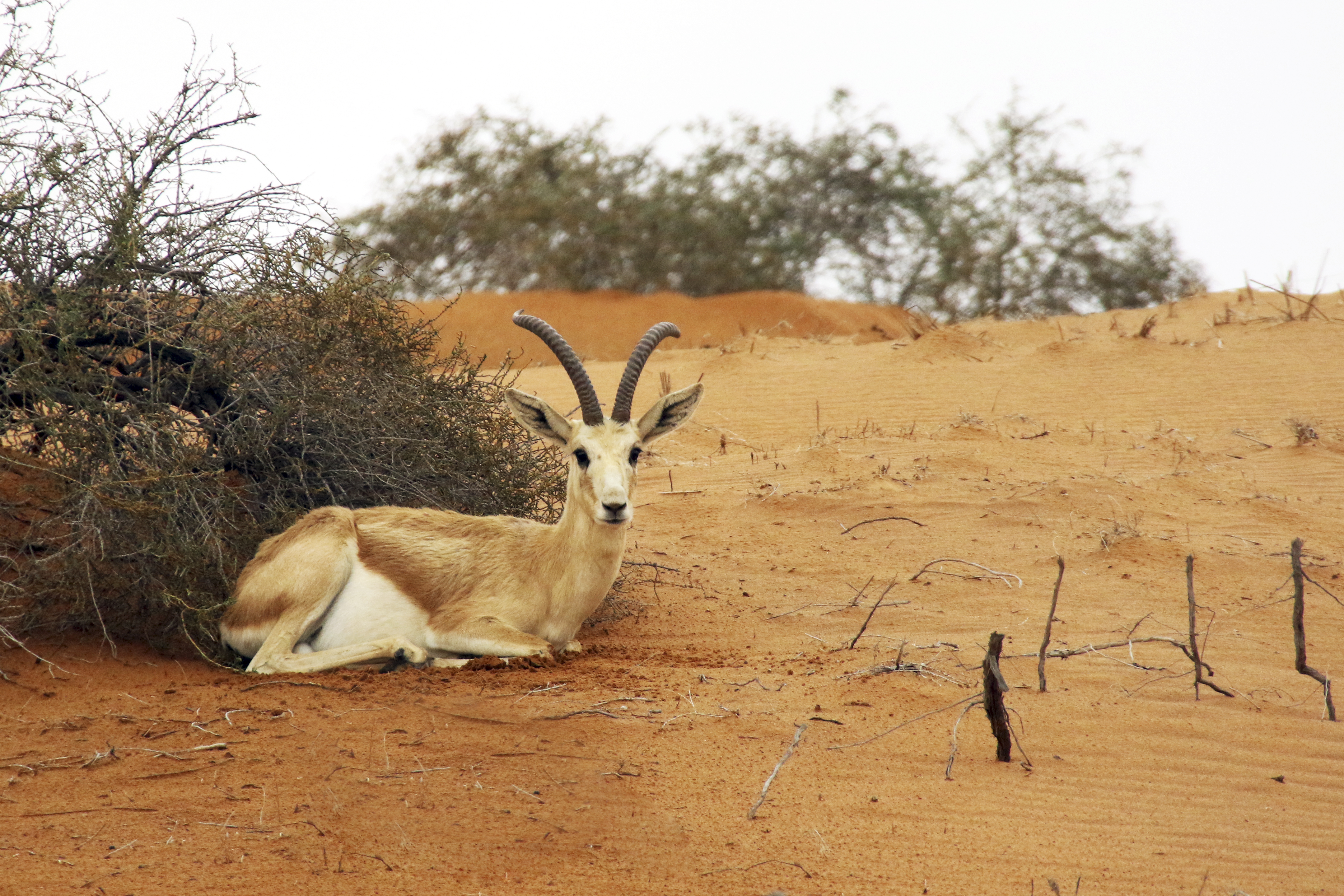Southwest Arabian Coastal Xeric Shrublands
The ecoregion’s land area is provided in units of 1,000 hectares. The protection goal is the Global Safety Net (GSN1) area for the given ecoregion. The protection level indicates the percentage of the GSN goal that is currently protected on a scale of 0-10.
Bioregion: South Red Sea & Gulf of Aden Coastal Drylands (AT22)
Realm: Afrotropics
Ecoregion Size (1000 ha):
4,155
Ecoregion ID:
107
Conservation Target:
22%
Protection Level:
1
States: Yemen, Saudi Arabia, Oman
The largest population of the Arabian gazelle in Saudi Arabia is the Farasan gazelle subspecies (Gazella gazella farasani) which inhabits the Farasan islands in the Red Sea. On the mainland, the species’ survival depends on a few remnant populations in the western Mountains and along the coastal plains. They have been classified as Vulnerable on the IUCN Red List and the total population is estimated at less than 12,000 globally and between 1,500–1,700 in Saudi Arabia. The majority of these (1,000) are found on the Farasan Islands.
The western side of the Asir Mountains and Yemen highlands drop sharply to a low, flat coastal plain, the Tihamah, where this ecoregion is found. It runs parallel with the Red Sea Coast, extending from just south of the Asir National Park in Saudi Arabia into Yemen, and then wrapping around the peninsula along the south coast and into Oman. The narrow coastal Tihamah plain is between 20 km and 50 km wide.
Within this ecoregion are islands found off the coast of Yemen in the Red Sea, including the Hanish islands; Jazirat Jabal Zuqar, Jazirat al Hanish as Saghir, and Jazirat al Hanish al Kabir, as well as the coral Farasan Islands, Kamaran and Jazirat Antufash. There is a warm desert climate, with mean annual temperatures around 30˚C, and it often exceeds 40˚C in summer. There is very little rainfall here and annual precipitation ranges between 50 mm and 200 mm. The southern part of the Tihamah is under the influence of the biannual monsoon cycle, which brings rains in late summer and during spring resulting in flash floods. The coastal plains includes sandy wadis and stony plains with halophytic and xerophytic plants as well as open Commiphora and Acacia woodlands. Doum palms and tamarisks are common.

The flagship species of the Southwest Arabian Coastal Xeric Shrublands ecoregion is the farasan gazelle. Image credit: Creative Commons
The Red Sea coastline of Yemen with all of the islands provide vital feeding and breeding sites for seabirds such as the crab plover, Persian shearwater, red-billed tropicbird, brown booby, sooty gull, white-eyed gull, lesser crested tern, and white-cheeked tern. A total of 125 bird species were recorded in Farasan Archipelago, among which, about 68 per cent were considered as migrant species. The Farasan archipelago is also an important plant area in the Arabian Peninsula. The Farasan gazelle was once widespread in Saudi Arabia, however populations have diminished throughout their range in the 20th Century due to hunting and competition for food with livestock.
Today, there are a few remnant populations on the mainland coastal plains, however, the Farasan islands contain the largest numbers of this species in Saudi Arabia. Other mammals present in this ecoregion include the hamadryas baboon, white-tailed mongoose, mountain gazelle, and the eastern spiny mouse. Two species of turtle are found along this coastline, which are the green turtle and the hawksbill turtle.
There are few protected areas in this ecoregion with only two present in Yemen; Zuqur Islands Marine National Park and Ras Isa Marine Park. The only protected area in Saudi Arabia within this ecoregion is the Farasan Islands resource use reserve (5,408 km2).
The main threats to the ecoregion are overgrazing by camels, sheep, and goats resulting in habitat degradation as well as reduced food availability for wild species, particularly ungulates. Another major threat here is wood cutting for fuel. Along the Saudi Arabia coastline, construction activities associated with urban expansion especially road and infrastructure, are causing disturbance to the vegetation. Agricultural activities in the region which use terraces along the Wadis in Tihamah, depend on ground water for irrigation causing the removal of natural vegetation at the Wadis' banks in the transformation process. On the Farasan Al-Kabir Island, the invasive species, Prosopis juliflora, threatens other vegetation. Gazelles are illegally hunted for meat and live capture for pets and private collections. The ongoing civil war in Yemen also threatens biodiversity and hinders conservation efforts.
The priority conservation actions for the next decade will be to: 1) increase the number of protected areas; 2) encourage sustainable grazing practices; and 3) ensure the environment and biodiversity are assessed and included in any construction plans for the region.

Farasan gazelles. Image credit: Creative Commons
Citations
1. Cunningham, P.L. and Wronski, T. 2011. Twenty years of monitoring of the Vulnerable Farasan gazelle Gazella gazella farasani on the Farasan Islands, Saudi Arabia: an overview. Oryx. 45(1), pp.50-55.
2. Krupp, F., Apel, M., Hamoud, A., Schneider, W. and Zajonz, U. 2006. Zoological survey in the Red Sea coastal zone of Yemen. Fauna of Arabia. 21, pp.11-32.
3. Masseti, M., De Marchi, G. and Chiozzi, G. 2015. Forbidden islands. The absence of endemics among the insular non-volant terrestrial mammalian fauna of the Red Sea. Natural History Sciences. 2(2), pp.101-130.




